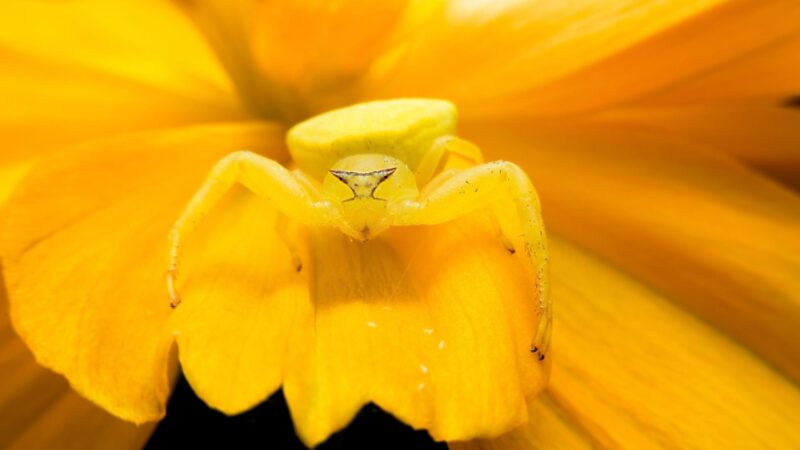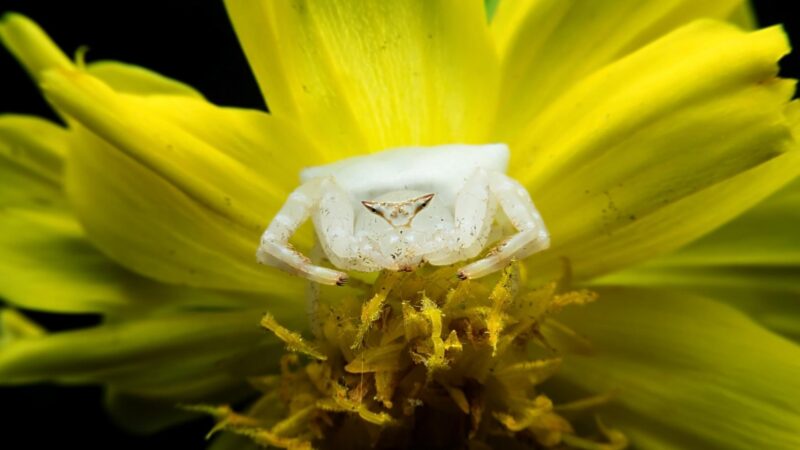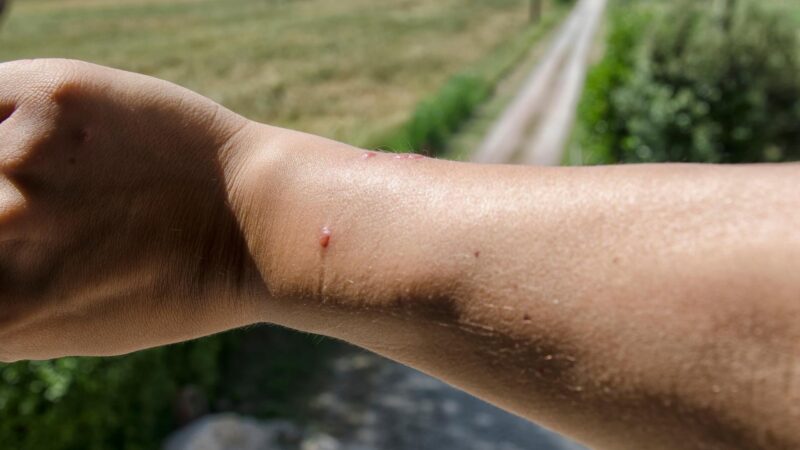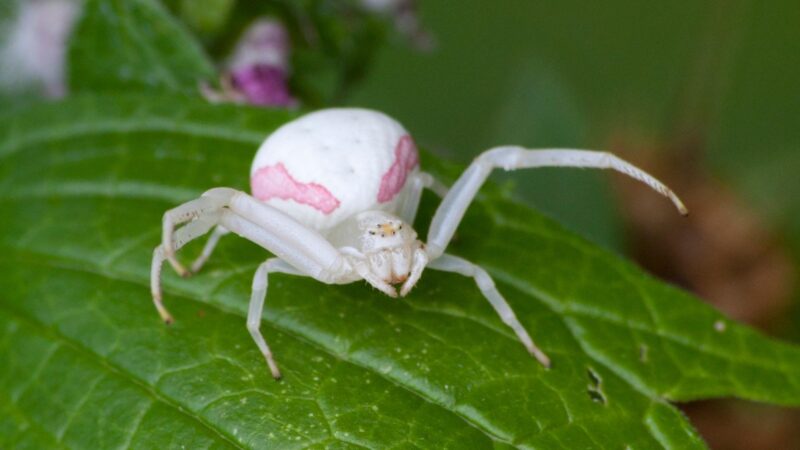The spider species with legs that project outwards is called crab spider. It has fangs that are smaller than other spiders, but it has venom that leaves its prey lifeless.
Luckily, it can’t seriously harm humans as its bite can only sting. This spider can’t tear your skin, but it can be painful.
How to treat crab spider bites? Once you confirm that you got bitten by a crab spider, get a cloth that you will use to clean the area. Do it carefully to remove any substance that the spider left on your skin. Put an ice pack on the bitten area for 15 minutes, or you can extend it if it’s necessary. Take a non-prescription anti-inflammatory drug to counter further adverse effects. You may also need a pain reliever.
Some people take tetanus shots to be protected from this kind of incident. You can receive a booster shot every ten years. However, crab spiders are not aggressive and dangerous to people.
They bite humans in special cases like they just do it to defend their eggs. Learn more about this spider species so you won’t fret and feel panicky when seeing it.
Table of Contents
Crab Spiders | Identification

The body of crab spiders is flat, wide, and short. As you can see, it was given a name based on its appearance, which is similar to a crab. The forelegs are notably larger than the hind ones.
You’ll likely see a crab spider that walks backward or sideways as it mostly uses its hind legs.
Just like other spiders, it has eight eyes with cephalothorax situated on the bumpy areas around its eyes. It’s the reason why they can see in all directions.
As for the color of crab spiders, it varies and changes to match their surroundings. For example, a crab spider mimics the color of the flowers where it’s hiding.
Crab spiders hunt alone during the day. Some of them remain in one place, but others venture to other areas in search of prey.
They do ambush attacks by making use of camouflage since they follow the colors of their habitat. When the prey is within reach, they use their forelegs to grab it.
The female is larger than the male. She doesn’t spin the web, but she uses her silk to protect the egg sac. The sacs are inside a leaf-covered by a silk. A male crab spider must be quick to escape after mating to escape death.
He can be eaten by the female. Anyway, he can easily crawl away due to his smaller frame.
The spiderlings look like the mini version of the adult. They shed skin as they grow bigger, but there are no changes in their form.
- Scientific Name: Thomisidae
- Appearance: With legs project outwards or arranged similarly like crab’s claws; two body segments; 8 legs
- Color: Diverse as it’s based on its surroundings (yellow, white, or dull color)
- Lifespan: It depends on the place where a crab spider lives. It usually dies in winter, and its life is extended when it’s in an area with a tropical climate.
- Habitat: Chaparral, desert or dune, forest, marsh, mountain, rainforest, swamp, scrub forest, taiga, temperate, terrestrial, tropical
- Size: Half an inch long
- Diet: Mites, insects, and pests
- Threat: Ants, birds, lizards, spiders, shrews, wasps, and other spiders
- Characteristics: Timid, non-aggressive
Do Crab Spiders Bite and Are They Poisonous?

Crab spiders can bite, and it’s usually the female that is being protective of their egg sacs. Their bite is not poisonous or even lethal to humans.
What Happens if a Crab Spider Bites You?

When a crab spider bites you, there will be a typical mark that is made by spiders. It has hollow fangs that create a pair of puncture wounds. Many skin abnormalities and lesions are mistakenly identified as spider bites.
Always remember that spiders will only leave one bite mark. If there are a lot of bites, it’s not the doing of a crab spider since this species can’t even break a person’s epidermis.
The venom from this spider only harms the small prey, but it’s not detrimental to humans. Crab spiders are too small to break human skin. Still, their bite can be painful. The bite can cause discoloration and swelling. These symptoms alleviate in just a few hours.
Symptoms of Crab Spiders Bite

Steve Jacobs from Pennsylvania State University stated that spiders rarely bite humans, and most of them are deemed harmless. Due to their small size, only allergic people or those with a compromised immune system are more vulnerable.
There are poisonous spiders, but the crab spider is not one of them. Even so, you have to be attentive to the symptoms, whether it’s manageable or need immediate medical attention. By knowing the symptoms, you would know that it’s indeed a crab spider that bit you.
- Discoloration
- Swelling
- Excruciatingly painful and it can be compared to what you feel when your fingernail is hit by a hammer
What Is the Best Treatment for a Crab Spider Bite?
The best treatment for a crab spider bite is a home remedy since it doesn’t cause serious adverse effects. Wipe the bitten area first then wash it with soap and water. The next step is to apply aloe or peppermint to the bite mark.
You can also get the aloe cream Cortizone. These substances have a cooling effect. Aside from relief, it helps with the healing process of the wound. You may also apply chamomile to reduce inflammation.
To lessen the pain, you can apply bergamot oil, rose oil, or lavender oil. Besides these homemade remedies, certain creams that you can get from the drug can ease the pain. You can either have the antibiotic ointment, analgesic cream, antihistamine cream, and hydrocortisone cream.
How Do I Get Rid of Crab Spiders in My Yard?
Based on the preferred habitat of crab spiders, you won’t likely see them inside your house. If you happen to see one of them, you can gently scoop it with your hands and set it free outside. Getting rid of them in your yard requires a different technique by using natural ingredients:
- Lemon – Squeeze some lemon and gather the juice as you need to apply it to the infested areas of your yard.
- Garlic water – Garlic is known as an effective insect repellent. So, you can mix it with water and spray it on the infested plants or other areas.
- Bleach – Bleach is not good for plants, so apply this in sections of your yard that don’t have plants.
You may also use an insecticide with safe formulations like Natria Insecticidal Soap or EcoVenger plant-based formula. They’re recommended as you may spray them directly to plants without causing harm.
Frequently Asked Questions
Are Pink Crab Spiders Poisonous?
Pink crab spiders are not poisonous, just like other species of crab spiders. They are scientifically called Thomisus onustus, and their colors are not always pink.
Their bodies can either be pink, yellow, or white, as it depends on the color of the flower where they reside. They have the ability to mimic the flower’s color to hide from predators and easily catch prey.
Is It Rare to Die From a Spider Bite?
It’s rare to die from a spider bite, as confirmed by an emergency doctor named Troy Madsen. The venom of most spiders doesn’t affect humans due to their larger frames and different physiology.
The species that are venomous to humans are black widow, brown recluse, redback, funnel-web, and Brazilian wandering.
What Happens When Spider Bites Get Infected?
When the spider bites get infected, these symptoms show up after half an hour to two hours that a person got bitten.
- Muscle cramps
- Rigid sensation in the abdomen
- Severe back pain
- Restlessness
- Nausea or vomiting
- Sweating
- Elevated blood pressure
What Do Doctors Do For Infected Spider Bites?
Apart from regular wound care, doctors administer fluids, pain relievers, and tetanus shots for infected spider bites. Anti-venom is the strongest treatment, but it’s reserved for those who experienced multiple bites at a time and in high-risk cases.
What Is the Best Antibiotic for a Spider Bite?
The best antibiotics for a spider bite are bacitracin, polymyxin, or neomycin. They’re all antibiotic topical ointments that you can directly apply to the spider bite.
Summary
Although crab spider bites are not venomous to humans, you still need to observe yourself if the symptoms get worse or not. Allergic reactions and compromised immune systems can change the common perception of a spider bite.
Of course, you need to alleviate the pain and soothe the swelling. But don’t forget that the first thing that you have to do is to clean the bitten area.
List of Sources
Crab Spiders (Family Thomisidae)